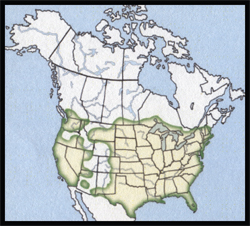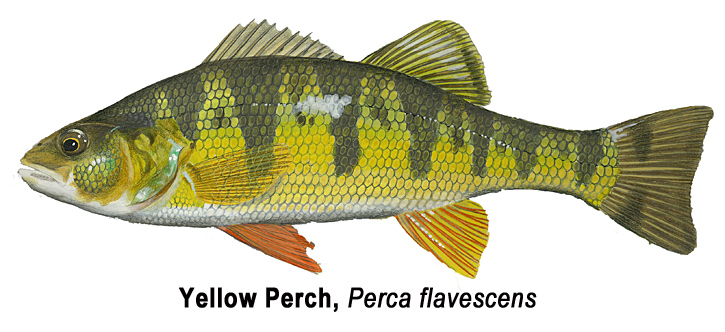Yellow Perch, September 2015, Fish of the Month!
Yellow Perch
Perca flavescens
Local Names:
Perch, Lake perch, Convict, American perch, Redfin perch, Yellow ned
Average Size:
5 to 10 inches
to ¾ pound
Distinguishing Field Marks:
(See the illustration.)
-
The intense yellow color and the series of broad vertical bands on the body of the Yellow perch are diagnostic, making it near impossible to mis-identify.
-
The mouth is of moderate size with its upper jaw extending back to the mid-point of the eye.
-
The first dorsal fin is tall and has 13 to 15 stiff rays. There is a deep notch between the first and second dorsal fins. The second dorsal fin has 2 spines on its leading edge.
The anal, pelvic, and pectoral fins are reddish in color, and are sometimes very brightly colored.
The anal fin has 2 spines on its leading edge.
North American Range:
Map to the right shows approximate range in North America.
Diet:
Immature aquatic insects make up a large proportion of the diet of the Yellow perch, a diet which also includes other aquatic invertebrates, such as crustaceans, and small fishes as well. This species is also known to feed heavily in season on the eggs of other fishes.
Biology:
Yellow perch spawn in spring at water temperatures of about 44 to 54 degrees F. Mature adults enter shallow near-shore waters with the males leading the usually larger females. Spawning occurs after dark or early in the morning, and may be accomplished over sand or gravel bottoms, but is usually done near fallen logs, brush piles or vegetation. The spawning act takes place with several males pressing their snouts close to the body of a larger female as the group swims about. The eggs are released and fertilized in a long gelatinous accordion-shaped mass which has a central channel and holes along its length. This egg cluster may be as much as 7 feet long, and 2 to 4 inches thick. They are semi-buoyant, contain an average of 3,000 to 60,000 eggs, and can move freely about, propelled by water and wind currents. These movements, which keeps the incubating eggs aerated, may also sweep them onto dry land where the eggs will perish before hatching. Most of the clusters will attach to the bottom or to vegetation where they will incubate. Depending on water temperature, the eggs may take from 8 to as many as 30 days to hatch. The young remain dormant for another 5 days while absorbing the yolk sac. Early growth is quite rapid. It should be noted that northern populations grow more slowly and live longer than those occurring in the south.
Fly Fishing for Yellow Perch:
Throughout their very broad North American range, Yellow perch inhabit an equally broad array of aquatic environments, from brackish coastal waters, to large lakes and ponds and the slow-moving waters of rivers and streams. Their primary requirement seems to be for a sustaining amount of rooted vegetation. That said, they are often encountered in open water away from any vegetation. They tend to live relatively close to the water's surface and to a maximum depth of only about 30 feet.
As with many of our smaller "panfish" species, none of us is likely to organize fishing travel specifically targeting Yellow perch, and probably anyone fishing in lakes or ponds within the Yellow perch's range will catch at least a few of these fish, if only as incidentals. If you do decide to fly-fish specifically for Yellow perch, you'll want to use some of your lightest outfits, from 3 to 5 weight line capacities. Your favorite light trout fishing outfits will do just fine. Wet flies and small streamers are your best bets, and should be presented on sink-tip lines fished at moderate depths around weed beds. These fish, especially the smaller ones, will frequently be found in dense schools that may move about just below the water's surface. Floating lines and high-floating dry flies or wets and small streamers (especially buck-tails) presented just below the surface can provide some extra fun when you find Yellow perch this way.
Because they are abundant and can be quite aggressive and non-discriminating about which artificials they'll take, Yellow perch are great fish for honing a young fly fisher's skills.
Significance to Humans:
Over the years, the Yellow perch has had a major significance to humans. It has historically been and continues to be a locally important commercial species. It is an excellent food fish and is harvested for market for that purpose. There are probably very few North American anglers who have not caught Yellow perch, whether intentionally or otherwise.
Yellow perch are hardy and can make a colorful addition to a large well maintained home aquarium.
Status:
Maintaining and thriving in most of its range. However there has been a recent significant decline in Yellow perch numbers in the Great Lakes, notably, Lake Ontario.







